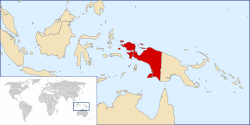
Back West-Neuguinea ALS غرب غينيا الجديدة Arabic Nueva Guinea Occidental AST Papua (wawidangan Indonésia) BAN Западна Нова Гвинея Bulgarian Papoua ar C'hornaoueg Breton Papua Occidental Catalan Západní Nová Guinea Czech Westneuguinea German Okcidenta Nov-Gvineo Esperanto
Western New Guinea
Papua West Irian / Irian Jaya / West Papua / Dutch New Guinea | |
|---|---|
 | |
| Country | Indonesia |
| Provinces | |
| Largest cities | |
| Area | |
• Total | 412,214.61 km2 (159,156.95 sq mi) |
| Population (mid 2022 estimate)[1] | |
• Total | 5,601,888 |
| • Density | 14/km2 (35/sq mi) |
| Demographics | |
| • Ethnic groups | Papuans, Ambonese, Bugis, Butonese, Evav/Kei, Javanese, Makassar, Minahasa, Toraja[2] |
| • Languages | Indonesian (official), Papuan Malay (lingua franca) and others[3] |
| Time zone | UTC+09:00 (Indonesia Eastern Time) |
| ISO 3166-2 | ID-PP[4] |
| Vehicle registration plates |
|
Western New Guinea, also known as Papua, Indonesian New Guinea, and Indonesian Papua,[5] is the western half of the island of New Guinea, formerly Dutch and granted to Indonesia in 1962. Given the island is alternatively named Papua, the region is also called West Papua (Indonesian: Papua Barat).[6] It is one of the seven geographical units of Indonesia in ISO 3166-2:ID.
Lying to the west of Papua New Guinea and geographically a part of the Australian continent, the territory is almost entirely in the Southern Hemisphere and includes the Biak and Raja Ampat archipelagoes. The region is predominantly covered with rainforest where traditional peoples live, including the Dani of the Baliem Valley. A large proportion of the population live in or near coastal areas. The largest city is Jayapura.
The island of New Guinea has been populated for tens of thousands of years. European traders began frequenting the region around the late 16th century due to spice trade. In the end, the Dutch Empire emerged as the dominant leader in the spice war, annexing the western part of New Guinea into the colony of Dutch East Indies. The Dutch remained in New Guinea until 1962, even though other parts of the former colony has declared independence as the Republic of Indonesia in 1945.[7] Following negotiations and conflicts with the Indonesian government, the Dutch transferred Western New Guinea to a United Nations Temporary Executive Authority (UNTEA), which was again transferred to Indonesia after the controversial Act of Free Choice.[8]
Papua is a province rich in natural resources and cultural diversity, offering great potential for future development.[9] Efforts to improve the region's Human Development Index, currently at 0.604, are ongoing, with significant investments in education, healthcare, and infrastructure. For example, the Trans-Papua Highway project is creating new opportunities for connectivity, trade, and tourism.[10] Additionally, the government's focus on empowering indigenous communities and promoting sustainable development is bringing economic and social benefits to the region. Despite the challenging terrain and climate of New Guinea, major infrastructure projects are being implemented, connecting remote areas and fostering economic growth.[11] The expansion of telecommunications services and renewable energy projects are further accelerating development in rural areas.[12]
The interior is predominantly populated by ethnic Papuans while coastal towns are inhabited by descendants of intermarriages between Papuans, Melanesians and Austronesians, including other Indonesian ethnic groups. Migrants from the rest of Indonesia also tend to inhabit the coastal regions.[13] The province is also home to some uncontacted peoples.[14]
In 2020, the region had a census population of 5,437,775, the majority of whom are indigenous;[15] the official estimate as of mid-2022 was 5,601,888.[1] It is currently governed as six autonomous provinces of Indonesia. The official language is Indonesian, with Papuan Malay the most used lingua franca.[16] Estimates of the number of local languages in the region range from 200 to over 700, with the most widely spoken including Dani, Yali, Ekari and Biak.[17] The predominant official religion is Christianity, followed by Islam. The main industries include agriculture, fishing, oil production, and mining.[citation needed] The province has a large potential in natural resources, such as gold, nickel, petroleum, etc.[18]
- ^ a b Badan Pusat Statistik, Jakarta, 2023.
- ^ Ananta, Aris; Utami, Dwi Retno Wilujeng Wahyu; Handayani, Nur Budi (27 June 2016). "Statistics on Ethnic Diversity in the Land of Papua, Indonesia". Asia & the Pacific Policy Studies. 3 (3). Wiley: 458–474. doi:10.1002/app5.143. hdl:10.1002/app5.143. ISSN 2050-2680. S2CID 156459190.
- ^ Gordon, Raymond G. Jr. (2005). "Languages of Indonesia (Papua)". Ethnologue: Languages of the World. Retrieved 15 March 2009.
- ^ "Indonesia Provinces". www.statoids.com.
- ^ "Indonesian Papua: A Local Perspective on the Conflict". International Crisis Group. 2007. Retrieved 23 April 2021.
- ^ Saltford, J. (2003). The United Nations and the Indonesian Takeover of West Papua, 1962–1969: the anatomy of betrayal (1st ed.). London: Routledge.
- ^ Vickers (2005), p. 139
- ^ Cite error: The named reference
McDonald 1980 36was invoked but never defined (see the help page). - ^ Badan Pusat Statistik (2020). Produk Domestik Regional Bruto Provinsi di Indonesia 2015–2019. Jakarta: Badan Pusat Statistik.
- ^ "Pemerintah Segera Bangun Jalan Trans Papua". Tribrata News. Kepolisian Negara Republik Indonesia. 2024. Retrieved 30 August 2024.
- ^ Jordan, Ray. "Jokowi: Pembangunan di Papua Sangat Sulit, Bertaruh Nyawa". detikfinance (in Indonesian). Jakarta: detikcom. Retrieved 25 February 2021.
- ^ "Pj. Gubernur Papua Ajak Kolaborasi Bangun Papua Lebih Baik". Pemerintah Provinsi Papua. 2023. Retrieved 30 August 2024.
- ^ Dagur, Ryan (5 November 2014). "Indonesia's transmigration program threatens Papuans". Ucanews.
- ^ "Papuan Tribes". www.survival-international.org. Survival International. Archived from the original on 29 July 2009. Retrieved 15 July 2017.
- ^ "BPS Provinsi Papua Barat".
- ^ Kluge 2014, p. 2.
- ^ HOWARD, Michael C. (2000). "Dress and Ethnic Identity in Irian Jaya". Sojourn: Journal of Social Issues in Southeast Asia. 15 (1): 1–29. ISSN 0217-9520. JSTOR 41057027.
- ^ "Sumber Daya Alam Papua – Guru Geografi". www.gurugeografi.id. Retrieved 25 February 2021.